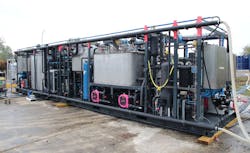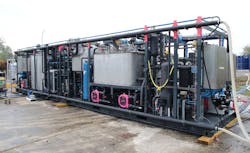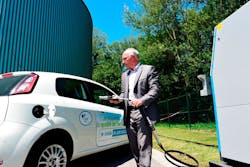French water treatment company Suez Environnement has developed an innovative new process that converts wastewater into liquefied biogas (LBG) using membrane based technology. So, how exactly does the technology work? What is the biomethane used for? And what are the potential uses of the BioGNVAL system in industrial applications?
Andrew Williams reports.
In recent years, there has been a growing recognition that biogas, a natural by-product of the anaerobic digestion of organic matter can be used to produce biomethane, a potentially abundant source of renewable energy. Following compression or liquefaction, biomethane can be pumped directly into the natural gas grid and used as a non-polluting fuel source for a variety of vehicles.
However, in some countries, the use of biomethane is limited - either because the domestic natural gas grid does not have enough capacity or because grid connections are located too far from production facilities - meaning that the resource is sometimes not exploited to its full potential.
In an effort to help in remedying this situation, SUEZ environnement has devised a new purification technology, known as BioGNVAL, which recovers some 40% of the available biogas that cannot be injected into the natural gas network, and converts it into a storable fuel that be transported over long-distances by lorries.
"In France, we can inject biomethane into [the] natural gas grid, but for many projects the grid won't have enough capacity or will be too far from the producer. So, the produc[tion] of LBG is a solution to valorise biomethane directly into biofuel or energy for industrial [applications] that are not connected to the natural gas grid," says Pierre Coursan, marketing manager - biogas and energy efficiency at SUEZ environnement.
Membrane treatment
In June 2014, the first membrane treatment demonstration unit producing biomethane using biogas from sludge digestion was installed - and is still currently operated - by the company at the Arvéa wastewater treatment plant in La Roche-sur-Foron, France.
The novel solution has also been under testing since December 2014 in Valenton, France at the Seine Amont wastewater treatment plant owned by the SIAAP (the Interdepartmental wastewater authority for the Greater Paris area).
After pre-treatment, the biogas is purified using the Valopur membrane based treatment technique, developed by SUEZ environnement 's partner Prodéval, which Coursan describes as a "simple, robust and open-ended process" that creates biomethane capable of being injected directly into the natural gas network - and which has also been successfully tested as a biofuel for a car.
Following this stage, the BioGNVAL solution is used to treat any surplus biomethane that cannot be pumped into the grid. As Coursan explains, the solution works by purifying the biogas and liquefying it "using cryogenic technology to reduce its volume by 1,000".
Coursan adds: "Membrane technology is very simple to use and very compact. It is also very robust. The system is modular [and] we can add membranes if necessary if flow rate grows. We tested the capacity of the membranes to adapt themselves to flow rate fluctuations and the results are good - the efficiency on methane is constant at 99.5%."
Unfavourable tariff system
For Coursan, the key advantage of the technology, which was developed by SUEZ environnement as part of a partnership with EReIE - an organisation specialising in the use of mixed refrigerant systems to produce clean energy - and supported by the French Environment and Energy Management Agency (ADEME) as part of its Investments for the Future programme, is the "unique system of refrigeration to purify the biogas and to liquefy the biomethane".
"The system is also easier to manage than classical systems which use two or three technologies to do the same thing," he adds.
Biogas also benefits from the fact that it is a durable and easily stored resource that is relatively methane-rich, and which is readily available as a by-product of existing infrastructural facilities, particularly at sewage treatment and other anaerobic digestion plants.
Even so, Coursan admits that, in common with many renewable energy technologies, the BioGNVAL solution would still benefit from continued public sector backing and more favourable tariff systems - and he regrets that the policy landscape in France is no longer as supportive as it once was.
"As for every renewable energy, LBG needs ... specific help from administration[s] to be developed. For example, there was a special tariff for biomethane injected into the natural gas grid or for electricity produced from biogas, which no longer exists in France," he says.
Biogas treatment unit
In September 2014, construction work began on another biogas treatment unit that will use the new technology, at the Strasbourg-La Wantzenau wastewater treatment plant, also in France.
According to Coursan, SUEZ environnement has signed a fifteen year agreement with Lyonnaise des Eaux and Réseau Gaz Distribution Services, under which biomethane produced at the facility will be injected into the city's natural gas network.
"As part of the Strasbourg project ... which is supported by the European Union's Life+ programme ... biomethane will be injected into the natural gas grid. We chose a membrane technology. Works are in progress and we would be able to inject in June [2015]," he adds.
SUEZ environnement has also recently won another fifteen-year contract - this time from the Greater Grenoble (France)-Alpes Métropole urban authority - to work alongside Gaz Electricité de Grenoble to build and operate a unit that will recover the excess biogas produced at the local Aquapole wastewater treatment plant and converting it into biomethane using the Prodéval membrane technology - before injecting the biomethane into the natural gas network. After the Strasbourg facility, the wastewater treatment plant at Grenoble will be only the second in France that is capable of injecting biomethane from sludge methanisation into the natural gas network.
A key feature of the Grenoble project is an innovative financial model, whereby Grenoble-Alpes Métropole receives a royalty from the income generated by the sale of the biomethane.
According to Coursan, the project will also facilitate the "local recovery" of part of the biomethane produced at the plant, which will be used to supply green fuel for urban transport - helping to create what he describes as "a sustainable local energy model".
Looking ahead, Coursan is also confident that there are a number of potential future commercial markets and applications for the BioGNVAL solution. One key growth area is likely to be the use of liquid biomethane in long distance transport by truck.
Since its establishment in May 2014 the EU-backed LNG Blue Corridors project has supported the installation of five dedicated LNG refuelling stations across the continent - the SGA Station in Sweden and the GOLD Station in Portugal, as well as the Gas Natural Fenosa in Spain, the ENI Station in Italy and the Drive System in Belgium.
"Whenever it is possible to inject biomethane directly into the natural gas grid, we can use simple technological solutions such as membranes or others," says Coursan. "However, with the development of CNG solutions for transport, for example through the ‘blue corridor project' in Europe, we will need more and more LBG solutions."
Andrew Williams is a freelance journalist for WWi. Email: [email protected].
*************
Strong Growth in the European Biogas Sector
Late last year, the European Biogas Association (EBA) published its annual Biogas Report. It revealed that current electrical and thermal energy production from biogas across Europe is roughly the same as the annual consumption of all the households in Belgium and Slovenia combined - equating to the output of some 15 coal power plants with an average capacity of 500 MWel.
Analysis of the data collected for the latest EBA report also confirms a continued upward trajectory - finding evidence for a strong increase in biogas production across Europe, as well as in the total number of biogas plants over the reporting period. In all, some 760 new plants opened in 2013 alone and annual biogas production across the continent is now 92.315 GWh/year.
In another encouraging development, the report also finds that, in common with biogas sector at large, the biomethane industry continues to experience strong growth - with a total of 282 plants across Europe, equating to a combined production of some 1.375 billion m3, currently in operation across the continent.
For the EBA, this rapid growth is at least partly due to what it describes as an increasing variety of "utilisation possibilities" - in particular, a massive rise in the number of biomethane filling stations, which more than doubled in 2013, in the process helping to increase the share of biomethane used in transport to "10% of the total produced biomethane in Europe".
"The most successful countries are indeed the largest producers at the moment - Germany, Italy, Switzerland, France, the Czech Republic and the UK," says EBA President, Dr. Jan Stambasky.
The EBA also earmarks the Scandinavian countries as key growth areas that continue to enjoy a steady rise. One particularly solid performer in the Nordic region is Finland, where the levels of biogas consumed in the transport sector has increased by 168% - making it the "dominant growth factor" for biogas across the nation.
Just across the Gulf of Finland, Estonia is also showing signs of strong growth - and the country is expected to establish a new investment support programme for biomethane plant constructions very soon. The EBA also reports that schemes to upgrade biogas plants by converting them to biomethane and grid injection facilities is now rising ‘in most of the biomethane producing countries,' - including France, but also Austria, Germany, the Netherlands and Sweden.
More Water & WasteWater International Archives Issue Articles





